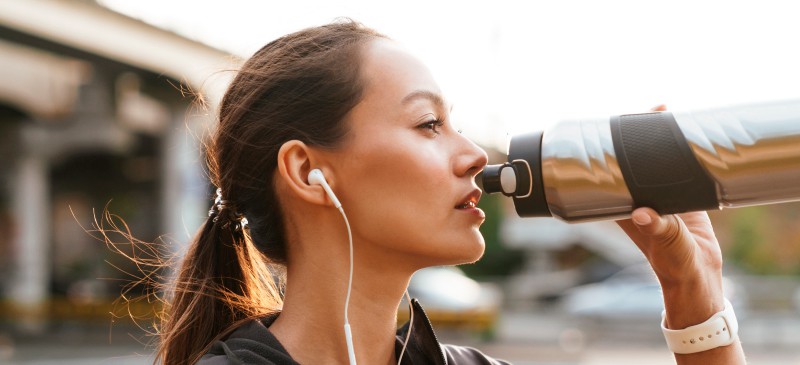Fact Checked
This Dr. Axe content is medically reviewed or fact checked to ensure factually accurate information.
With strict editorial sourcing guidelines, we only link to academic research institutions, reputable media sites and, when research is available, medically peer-reviewed studies. Note that the numbers in parentheses (1, 2, etc.) are clickable links to these studies.
The information in our articles is NOT intended to replace a one-on-one relationship with a qualified health care professional and is not intended as medical advice.
This article is based on scientific evidence, written by experts and fact checked by our trained editorial staff. Note that the numbers in parentheses (1, 2, etc.) are clickable links to medically peer-reviewed studies.
Our team includes licensed nutritionists and dietitians, certified health education specialists, as well as certified strength and conditioning specialists, personal trainers and corrective exercise specialists. Our team aims to be not only thorough with its research, but also objective and unbiased.
The information in our articles is NOT intended to replace a one-on-one relationship with a qualified health care professional and is not intended as medical advice.
May 17, 2023



You lose electrolytes every day when you urinate, sweat, or if you’re sick and experience vomiting or diarrhea. That’s when electrolyte drinks can come in handy. When electrolyte levels dip below normal levels, you can experience symptoms like fatigue, muscle weakness, headaches, nausea, blood pressure changes, cramps and more.
What is the best drink to replace electrolytes? While there are all kinds of bottled electrolytes drinks available in stores, such as Gatorade and other “sports drinks,” not all types are great choices.
Either choosing more natural sources of electrolytes, such as coconut water, or making your own sports drink alternative is a good way to avoid high-calorie, high-sugar sports drinks. Homemade electrolyte water, for example, helps you control the ingredients that you add and can do just as good of a job at preventing dehydration as most commercial drinks.
What Is An Electrolyte Drink?
Electrolytes are a group of essential minerals that we must get regularly from our diets. They got their name because they are basically electrically charged minerals.
This group includes sodium, calcium, magnesium and potassium, which all have critical functions in the body — including aiding in hydration and many muscle, heart and nerve functions.
Ad


The primary reason that sports drinks were created was to help replace electrolytes that are lost through sweat. The problem with commercial sports drinks, such as Gatorade, Powerade and others, is that they’re often high in both calories and sugar — plus they usually contain artificial sweeteners, flavors, colors and other not-so-great chemicals. As one dietician explains, “Sugar, salt, and water help your body absorb fluids, but a lot of sports drinks have too much sugar and not enough electrolytes to really help your body replenish the electrolytes it needs.”
Electrolyte water and other similar drinks are most beneficial for endurance athletes who complete long, high-intensity workouts, as well as people who are sick and losing fluids.
READ RELATED: Adding This Type of Alt Milk to Spinach Smoothies Can Dial Up the Drink’s Anti-Inflammatory Factor Significantly, Says an RD
Benefits
When you consume low-sugar drinks with electrolytes, such as the types listed below, they can offer some of the following benefits:
- Preventing an electrolyte imbalance, in which you’re low in certain minerals, such as potassium or sodium
- Promoting hydration and preventing dehydration
- Reducing muscle spasms and cramps
- Balancing fluids inside your body, which can decrease bloating and swelling
- Managing side effects from vomiting and diarrhea, such as fatigue, lightheadedness, dizziness and nausea
- Decreasing hangover symptoms, such as weakness and fatigue
- Regulating blood pressure levels
- Helping regulate cell and nerve functioning
- Assisting in balancing your pH levels (the measure of acidity and alkalinity)
Best Electrolyte Drinks
It’s most helpful to choose types that provide water, sodium, and some potassium or magnesium. These may be available as tablets, powders or pre-made drinks.
Ideally, choose those that are low in added sugar, made with mostly organic ingredients, and are free of artificial flavors and ingredients, including colors, preservatives and sweeteners.
Here are our top electrolyte drinks choices:
- Coconut Water with Added Salt — Coconut water naturally contains minerals, including a good dose of potassium plus some sodium and calcium, however your body also usually needs extra sodium if your’e dehydrated. Adding some sea salt to coconut water is an easy way to increase your sodium intake. This combination seems to be just as effective at promoting hydration as some commercial electrolyte drinks.
- Essentia Water — This is a type of alkaline water that’s also infused with small amounts of electrolytes, plus it’s free of sugar, carbs and additives.
- Ultima Replenisher Electrolyte Drink Mix — Contains no sugar, is calorie-free, and supplies you with potassium, sodium and magnesium.
- Nuun Sport Electrolyte Hydration Tablets — Only has 15 calories per serving, 1 gram of sugar and is sweetened with stevia.
- NOOMA Organic Electrolyte Sports Drink — Organic, made with a coconut water base and free of added sugar since it’s sweetened with stevia.
- Hydrant Electrolyte Powder Rapid Hydration Mix — Contains 4 grams of sugar per serving and 25 calories and provides a good dose of potassium, sodium, magnesium and even zinc for immune support.
- Propel Immune Support with Vitamin C + Zinc — This is a good no-sugar option that provides sodium and potassium.
- Keto Electrolyte Capsules or Powders — Some companies make supplements aimed specifically at keto dieters who are looking for zero-sugar options. If you’re following the keto diet, opt for a mix that’s high in B vitamins, salt, magnesium and potassium.
How to Make
The simplest drink with electrolytes to make at home is electrolyte water that includes essential minerals. You’ll want to add some sodium and magnesium, along with perhaps calcium, phosphorus and chloride.
While added sugar isn’t usually the best thing to include in your diet, a little bit from a healthy source, such as natural sugar or 100 percent juice, isn’t necessarily bad in small amounts when you’re active and in need of carbohydrates.
Here’s how to make a basic electrolyte water drink (makes 4 cups/4 servings):
- Combine 2 cups water with 1.5 cups of unsweetened coconut water.
- (Optional) Add about 1/4 cup of 100% juice to improve the taste, such as tart cherry, orange or pomegranate juice. You can also add lemon juice or lime juice for extra benefits and taste.
- Add 1/4 teaspoon of high-quality sea salt.
Each serving (about 1 cup) provides about 250 milligrams of sodium, 250 milligrams potassium and 90 milligrams of calcium.
Dosage
Can I drink electrolyte water every day?
You probably don’t need to if you typically only exercise moderately, drink enough water and fluids throughout the day, and eat an otherwise balanced, healthy diet.
However, if you complete long and intense workouts often, this is the perfect time to incorporate electrolyte drinks into your routine — since these types of workouts cause you to lose electrolytes due to excessive sweating.
When should I drink electrolytes?
Basically anytime you’re sweating a lot, losing fluids from being sick or not drinking enough water to stay hydrated is when these drinks are helpful.
Whenever you’re completing a tough workout, such as a marathon or triathlon, it’s a good idea to sip on a drink with electrolytes. Other times in which electrolytes drinks can be helpful include when you’re doing any hour-plus long runs, hikes, bike rides, cycling, heated yoga or HIIT classes.
Additionally, if you’re vomiting or have diarrhea — due to being sick or even hungover — then consider having electrolyte water or another similar drink to stay hydrated. A night of heavy alcohol consumption can lead to fluid loss and dehydration, so consuming drinks with electrolytes after drinking alcohol is a smart idea.
Ad


How much electrolytes do we need each day?
This really depends on your body size, gender, where you live and how active you are. Here are general recommendations according to the Dietary Guidelines for Americans:
- Sodium: <2,300 milligrams/day for adults
- Potassium: 3,400 milligrams for men and 2,600 milligrams for women
- Calcium: 1,000 milligrams for men and women
- Chloride: 2.0 grams/day for adults
- Phosphorus: 700 milligrams/day for adults
- Magnesium: Between 310 and 400 milligrams/day for adults
Risks and Side Effects
Can electrolyte drinks be harmful? Overall they are safe to consume if you don’t overdo it and if you avoid consuming commercial types that are full of sugar and other processed ingredients.
If you suspect that you’re experiencing an electrolyte imbalance, look out for symptoms like dizziness, weakness, dry mouth, headache, cramps and fatigue. If adding electrolytes to your diet isn’t helping manage these symptoms after a few hours, then head to your doctor to rule out potential other causes, such as a fever or another illness.
Conclusion
- Electrolytes (including sodium, magnesium, calcium, phosphorus and chloride) are minerals that we must get from our diets regularly since they have many roles. We lose them when we sweat a lot and from urinating, vomiting, diarrhea or being hungover.
- Electrolyte drinks help replenish these minerals and prevent side effects liken fatigue, cramps, weakness and headaches. These can come in premixed liquid form, tablet or powder form.
- Coconut water is one of the best and most natural options for maintaining these minerals. It’s even better if mixed with salt for extra sodium.
- Is Gatorade good for replenishing electrolytes? Because it’s high in sugar and calories, other options are better choices. Ideally, choose those that are low in added sugar, made with mostly organic ingredients, and are free of artificial flavors and ingredients.
!function(f,b,e,v,n,t,s)
{if(f.fbq)return;n=f.fbq=function(){n.callMethod?
n.callMethod.apply(n,arguments):n.queue.push(arguments)};
if(!f._fbq)f._fbq=n;n.push=n;n.loaded=!0;n.version=’2.0′;
n.queue=[];t=b.createElement(e);t.async=!0;
t.src=v;s=b.getElementsByTagName(e)[0];
s.parentNode.insertBefore(t,s)}(window, document,’script’,
‘
fbq(‘init’, ‘3475171552810057’);
fbq(‘track’, ‘PageView’);




